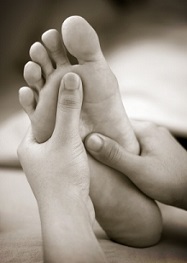
Plantar Fasciitis and Massage

The information here is my personal interpretation of the comments made on the podcast about plantar fasciitis mainly for my own reference and posted here for general interest. It is not intended to replace or to be a substitute for medical advice by a trained physician and healthcare practitioner.

Fasciitis implies inflammation of the fascia but what is more likely to be happening is an -oscis. Maybe there was an initial injury but there may be maladaptive changes but they are not necessarily inflammatory. Breakdown of the structural integrity of the plantar fascia. The layers are to aid transferring of the weight through the foot and the body. Any damage takes a long long time heal – it’s a stubborn condition. We can exercise correctly and do any number of home remedies but no matter what you do, it will take a long time to heal.
In a conventional medical approach with this kind of foot pain then they may recommend taping or a boot to keep the foot in a slightly dorsiflexed position during sleep. This may result in a slightly stronger structure when we start to walk in morning. Cortisone injections are used but not as anti-inflammatory. Cortisone may melt the connective tissue to aid healing. But the problem with that is that it weakens the plantar fascia so leave you at the risk of rupture (& you can only have a limited number of cortisone shots). Not necessarily a permanent solution.
Massage may help – not only to the foot and the intrinsic muscles. Also need to work on the muscles that affective the foot strike eg tibialis posterior, flexor digitorum longus and flexor hallucis longus. The more functional they are then the better the foot strike – won’t necessarily solve the plantar fasciitis but may make it a little easier to live with. Be aware that as a massage therapist, you will not solve genuine plantar fasciitis in one session; it will take weeks.
Can be caused by a traumatic incident eg foot suddenly hitting the ground but more commonly it’s a more gradual onset. Wearing shoes that always support the foot is recommended.

Condition is frequently present in active people. There are other conditions that has similar symptoms to plantar fasciitis so just be mindful of this when someone presents with plantar fasciitis type symptoms.
Whilst it was traditionally considered as an inflammatory condition, the indications are that plantar fasciitis is more likely to be a degeneration of collagen. For massage therapists then treatment will rarely be isolated to the plantar fascia and the whole kinetic chain may need to be addressed. Eg lower leg biomechanics and loads on the foots. May require activity modification. Muscles that it is important to address are the intrinsic muscles of the foot, deep compartment muscles that impact on foot biomechanics (tibialis posterior, flexor digitorum longus and flexor hallucis longus – whose tendons all pass down medial side of ankle). Irritation of tibialis posterior tendon on the foot may mirror some of the pain symptoms associated with plantar fasciitis.
Please be aware that the plantar fascia is very thick and dense connective tissue and any manual therapy will have negligible impact on the plantar fascia. Any changes are more likely to be associated with neurological impact and/or changes in the way that the plantar fascia is loaded biomechanically.
Whilst there is some doubt about validity of a fascia trains type model (if connective tissue is tethered along its length then how can force be transferred?) then the sensation of pain may be affected by other areas that are seemingly not connected. Hence working extensively to reduce sensations elsewhere in the body may impact on the level of pain associated with plantar fasciitis – even if it not mechanical.
Be aware nerve entrapment eg in the tarsal tunnel which can mimic plantar fasciitis pain. By stressing the nerve by working away from the plantar fascia may be a suitable technique to assess whether you are looking at a nerve issue or plantar fasciitis.
Characteristics of plantar fasciitis are that there is pain on first steps in the morning. However, if you palpate on medial side of ankle and that makes foot pain worse then more likely to be nerve issue.

Plantar fasciitis affects both athletes, weekend warriors and sedentary people. Asks patient “What provokes the pain? What eases the pain? What treatments have they had and what were the affects of them?”
Performs detailed clinical assessment, asking lots of questions and finding out such things as where does it hurt. Important to find out if it is genuinely plantar fasciitis as there are many “experts” out there quick to give a diagnosis. Checks out range of motion of the ankle, does it vary side to side (not necessarily causative if there is a difference). “Can I provoke the sensation with light touch or stretch? If can then often moves straight into treatment.
This involves lying on side with the arch of the affected foot facing up and perform the traditional myofascial cross handed stretch – one hand at calcaneus, other at the base of the meta-tarsals. How does that feel for the patient?
Likes to treat shin (anterior, posterior, medial and lateral). Self treatment might include soft tissue work coupled with loading; resistance and weight bearing exercises + movement exercises.
If pain is more at the medial aspect of the calcaneus then probably more likely to consider nerve pathways rather than fascia but there is always some degree of overlap and always wise to consider both nerve and fascia.
YouTube Plantar Fasciitis Massage Demonstrations
Massage Sloth
Rebel Massage